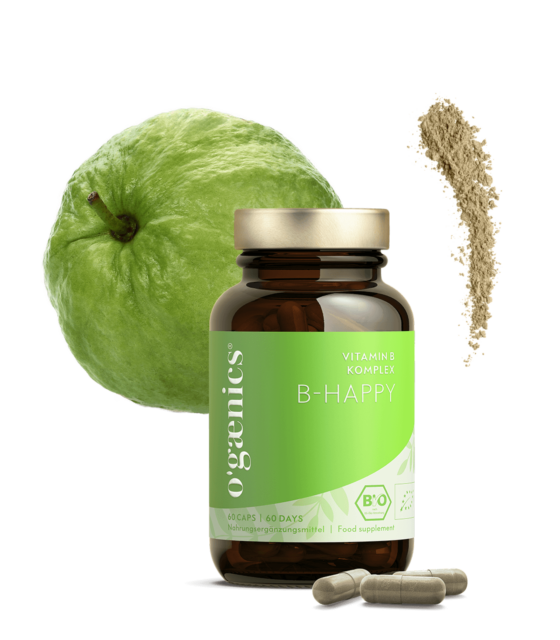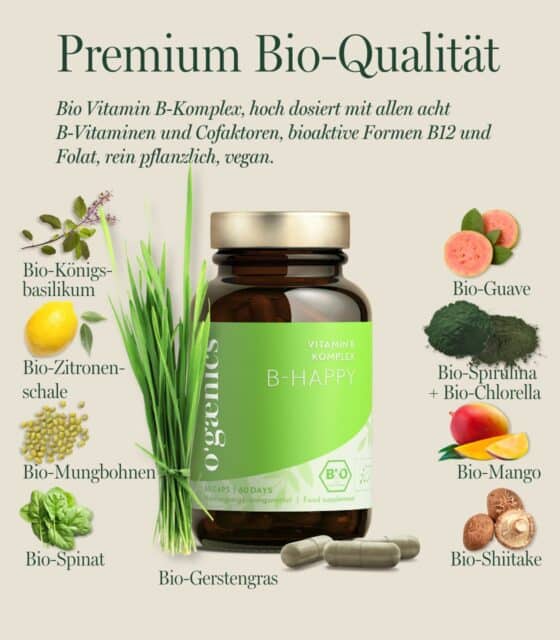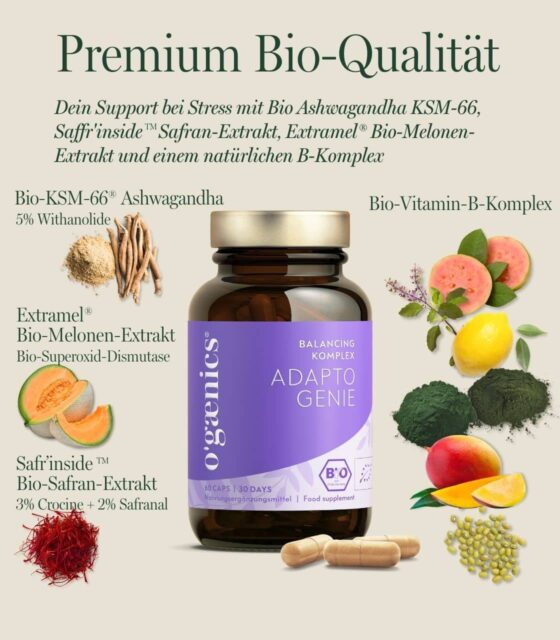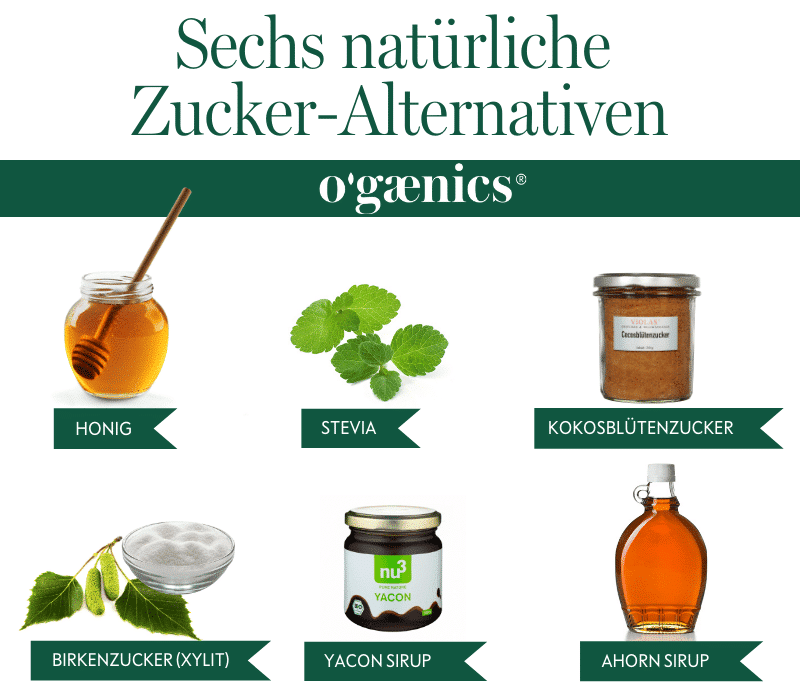Are honey, agave syrup or stevia really healthier? We compared twelve sugar alternatives.
Are you looking for alternatives to conventional sugar? When it comes to sugar alternatives, things are starting to get complicated. Because normal household sugar has long since ceased to be the only problematic sweetener. Even agave syrup, once touted as one of the healthiest natural sugar alternatives, is now routinely pilloried for its high fructose content.
How are you supposed to find your way around? And when is a sugar “healthy” anyway? Before we reveal the advantages and disadvantages of each sugar alternative, let’s first briefly review the three most important criteria. To evaluate your sweet treats in the future, it’s best to pay attention to the fructose content, glycemic index (GI) and calorie count of your sweetener.
Fructose content of the sugar alternatives
The problem with fructose is that we have had very little contact with it in our evolutionary history. This was because fructose was an extremely rare sugar that was only available when the fruit was ripe. Consequently, our bodies have not been evolutionarily prepared for these amounts of fructose that flood us today in everyday life. We have never been exposed to so much sweet fruit, fruit juices, sodas and candy as we are today.
Normal household sugar, for example, consists of 50 percent fructose. The other part is glucose. The latter is the most important fuel for life on earth. Glucose is the “good” sugar because it can be used by all cells for energy and is essential for some parts of our body.
Fructose is metabolized by the body in a completely different way than glucose. While every single cell in our body is able to use glucose, in the case of fructose, only the liver is able to metabolize it. So when we eat fructose-rich foods, our liver becomes overloaded. Moreover, the fructose is directly converted into fat, which is fatal for our weight and health.
A good rule of thumb for most healthy people is that fructose becomes harmful at around 50 grams per day. So, considering that most fruits are half glucose and half fructose, even more than 100 grams of sugar from fruits each day can become problematic. So make sure your sweetener contains as little of it as possible.
Glycemic index of sugar alternatives
The glycemic index of a sugar alternative tells us how quickly our blood sugar level rises due to this sweetener. The glycemic index can therefore be used to compare the effect of different sugar alternatives on blood glucose levels.
The glycemic index is determined by three aspects for sweeteners:
- Amount of carbohydrates contained
- Type of carbohydrates
- Presence of other substances. One example is fiber, which can slow down the digestion of carbohydrates (and thus have a positive effect on blood sugar levels).
For example, glucose has a glycemic index (GI) of 100 and fructose has a GI of 25.
Regular table sugar is a combination of these two types of sugar and has a GI of 65.
A GI <50 is considered low and is therefore desirable in order to maintain as constant a blood glucose level as possible. We explain why this is so important, for example, to burn fat, in the article “Blood sugar: the secret to losing weight”.
So make sure your sugar alternative has as little impact on your blood sugar levels as possible.
Sugar robs B vitamins
Unfortunately, most sugar alternatives provide little or no nutrients. They only unnecessarily burden your calorie account with “empty” calories. To metabolize these empty calories, your body uses up nutrient reserves it needs to stay healthy. These often include B vitamins.
So make sure to always eat as few empty calories as possible. This will conserve your nutrient stores, giving you all the more opportunities to consume calories in the form of healthy and nutrient-dense foods.
These supplements contain plant B vitamins to balance
If you often can’t resist the sweet temptation, you should definitely increase your intake of B vitamins in a targeted way. You can do this, for example, with nutritional supplements.
You can find natural B vitamins from organic plants at Ogaenics e.g.
- normal dosage in Beauty and the Bs Pure Skin Complex against blemished skin
- medium-high doses in the Adapto Genie Balancing Complex (ideal if you have a lot of stress and your body uses more B vitamins as a result)
- high dosage in Ogaenics B-Happy Vitamin B Complex (ideal if you are already deficient or subject to extreme hormonal fluctuations)
-
Bestseller
Adapto Genie
Bio Balancing Complex with premium KSM-66® Ashwagandha, Safr'inside™ saffron extract, B vitamins74,90 €2.547,62 € / kg
12 sugar alternatives in comparison
| Sugar type | Fructose content | glycemic index (GI) | Calories per 100g |
| White sugar (table sugar) | 50% | 65 | 387 |
| Brown sugar | 50% | 65 | 387 |
| Whole cane sugar | 50% | 35 | 399 |
| Fructose | 100% | 25 | 390 |
| Artificial sweeteners (e.g. aspartame, saccharin, cyclamate) | 0% | 0 | 0 |
| Honey | approx. 45 | 50 | 302 |
| Agave syrup | 70-90% | 15 | 304 |
| Maple syrup | approx. 35 | 54 | 260 |
| Stevia | 0% | 0 | 0 |
| Coconut blossom sugar | 45% | 35 | 378 |
| Yacon syrup | 75% | 1 | 197 |
| Rice syrup | 0% | 98 | 327 |
| Sugar alcohols (e.g. sorbitol mannitol, isomalt, maltitol, lactitol, xylitol/birch sugar, erythritol) | Only xylitol and erythriol are not converted into fructose | 240 |
White sugar (table sugar)
Household sugar is a so-called twofold sugar, which is broken down into glucose and fructose in the blood.
Advantages: We perceive household sugar as having a neutral taste.
Disadvantages: It has a high glycemic index and many calories. Sugar also damages the teeth.
Brown sugar
Brown sugar is identical to white sugar. The brown color comes simply from syrup residues.
Advantages: Brown sugar, like table sugar, is neutral in taste.
Disadvantages: It has a high glycemic index and many calories. Brown sugar damages teeth just as white sugar does .
Whole cane sugar
Whole cane sugar is obtained from sugar cane and is less sweet than table sugar. It has a slightly caramel flavor.
Advantages: It contains minerals and trace elements in minute quantities.
Disadvantages: Whole cane sugar raises blood sugar levels just as white sugar does and can damage teeth just as much.
Fructose
Industrially processed, isolated fructose is found in many processed foods.
Advantages: Fructose is 2.5 times sweeter in taste than table sugar, so you need less of it.
Disadvantages: Excessive consumption attacks the intestinal flora and can lead to leaky gut syndrome. Fructose is also a risk factor for gout, kidney stones, cardiovascular disease and can damage teeth.
Artificial sweeteners (e.g. aspartame, saccharin, cyclamate)
Advantages: Artificial sweeteners like saccharin have no glycemic index and no calories. They are therefore suitable for diabetics who otherwise have a limited choice of sweeteners. They are also harmless to the teeth.
Disadvantages: Artificial sweeteners do not increase blood sugar levels, but they still have an impact on our bodies. They also have a high addiction potential and trick the brain. This is because the brain is programmed to react to the taste of sweet things.
Studies have shown that the pancreas releases insulin as soon as we have the sweet taste on our tongue – whether the substance contains calories or not. So the body is fooled by the zero-calorie sweeteners. He expects glucose to enter the bloodstream and waits in vain. This can lead to an increased appetite soon after. Some studies have already shown that the zero-calorie substances are not suitable for reducing weight.
Honey
Honey is a natural product and consists of 80 percent sugar – namely fructose, glucose, sucrose and other polysaccharides.
Advantages: Honey is very sweet in taste, so you need less of it compared to sugar. If it is natural, it contains vitamins, minerals and amino acids.
Disadvantages: Honey, just like table sugar, is very high in calories. It can damage teeth and has a relatively high glycemic index. Industrially processed honey is also pasteurized, which destroys the ingredients. We therefore recommend that you always buy your honey directly from the beekeeper.
Agave syrup
Agave syrup is obtained from the agave from Mexico.
Advantages: Agave syrup is a natural product and sweeter than sugar. Accordingly, you need less of it compared to household sugar. Agave syrup has a low glycemic index, which is good for your blood sugar levels. It is vegan and thus an alternative to non-vegan honey.
Disadvantages: Its very high fructose content stresses the liver. Agave syrup can cause metabolic syndrome and also damage teeth.
Maple syrup
Maple syrup is obtained from the bark of the maple tree.
Advantages: Maple syrup is only 60 percent sugar. It is therefore less sweet than household sugar and tastes spicy. As a natural product, it also contains vitamins, antioxidants and anti-inflammatory substances, but only in minute quantities. Its calorie count is also somewhat lower than that of sugar.
Disadvantages: The glycemic index of maple syrup is high and, like sugar, it can damage teeth.
Stevia
This natural sweetener is extracted from the leaves of the South American perennial Stevia rebaudiana.
Advantages: Stevia is 300 times sweeter than sugar and has no calories, no effect on blood sugar levels and is harmless to teeth. Stevia can easily be used in cooking, baking and beverages.
Disadvantages: Stevia is unfortunately not neutral in taste but slightly bitter. Similar to artificial sweeteners, it increases the desire for sweets and tempts people to eat more.
Coconut blossom sugar
Coconut blossom sugar is made from the nectar of the coconut palm, but it does not taste of coconut, but has a more caramel flavor.
Advantages: The glycemic index of coconut blossom sugar is slightly lower than that of regular sugar. It also contains fiber, minerals and trace elements.
Disadvantages: The number of calories and the negative effect on dental health are comparable to household sugar. Diabetics must calculate coconut blossom sugar like normal white sugar.
Yacon syrup
Yacon syrup is based on fructo-oligosaccharides from the yacon root, which are not metabolized by the body.
Advantages: Yacon syrup is a low calorie and low glycemic sweetener from nature. Since Yacon syrup has no effect on blood sugar levels, it is perfectly suitable for diabetics. It also contains minerals and vitamins (e.g. B1, B2, C).
Disadvantages: Yacon syrup is very high in fructose, which makes it hard on the liver.
Rice syrup
To make rice syrup, cooked rice is exposed to enzymes that break the starch it contains into smaller sugar molecules. The result is a thick sugar syrup consisting of maltotriose (52%), maltose (45%) and glucose (3%).
Advantages: Rice syrup does not contain fructose and therefore does not burden the liver.
Disadvantages: With a GI of 98, rice syrup has the strongest effect on blood sugar levels, really messing them up. The “empty” calorie count here is also very high. Therefore not recommended.
Sugar alcohols (sorbitol, mannitol, isomalt, lactitol and xylitol)
The often chemical-looking name is deceptive. This is because the so-called sugar alcohols are obtained from fruits and vegetables.
Advantages: The taste is similar to sugar, but less sweet. With a GI <15, they have almost no negative effect on blood sugar levels, but unlike artificial sweeteners, they do provide a few calories. They are also perfectly suitable for diabetics.
Disadvantages: However, in sensitive people, sugar alcohols can cause abdominal cramps and even have a laxative effect in quantities >20g/day.
Conclusion
In conclusion, we can state: The perfect sugar alternative does not exist. In general, it is recommended to reduce sugar and its alternatives to a minimum and at the same time to sharpen the sense of taste again. Because that way we need less of the sweet poison. When choosing a sugar alternative, you should always consider the fructose content, glycemic effect and calorie count.
Are you still interested in the topic of sugar? Then just keep clicking! You might also like the following article: The 6 most important reasons to avoid sugar. or learn how you can eat healthier and pay more attention to your acid-base balance: Acid-base balance – what makes us acidic?












 No products in the cart.
No products in the cart.